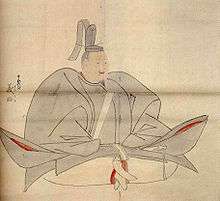Ashikaga Yoshiaki
| Ashikaga Yoshiaki | |
|---|---|
 | |
| Born | December 5, 1537 |
| Died | October 19, 1597 |
| Occupation | Fifteen Shogun of the Ashikaga shogunate |
Ashikaga Yoshiaki (足利 義昭, December 5, 1537 – October 19, 1597)[1] was the 15th shogun of the Ashikaga shogunate in Japan who reigned from .[2] His father, Ashikaga Yoshiharu was the twelfth shogun, and his brother, Ashikaga Yoshiteru was the thirteenth shogun.[3]
Life
The absence of an effective central authority in the capital of Japan had lasted until the warlord Oda Nobunaga's armies entered Kyoto in 1568,[4] re-establishing the Muromachi Shogunate under the puppet shogun Ashikaga Yoshiaki to begin the Azuchi–Momoyama period. Ashikaga Yoshihide, the fourteenth shogun, was deposed without ever entering the capital.
Most historians consider 1573 to have been the year in which the Ashikaga shogunate ended. The power of the Ashikaga was effectively destroyed on August 27, 1573 when Nobunaga drove Yoshiaki out of Kyoto. Yoshiaki became a Buddhist monk, shaving his head and taking the name Sho-san, which he later changed to Rei-o In.[5]
Some note that Yoshiaki did not formally relinquish his empty title; and for this reason, the empty shell of the shogunate could be said to have continued for several more years. Despite a renewed central authority in Kyoto and Nobunaga's attempt to unify the country, the struggle for power among warring states continued until unification and final peace was achieved long after his assassination in 1582.
Events of Yoshiaki's bakufu
Significant events shape the period during which Yoshiaki was shogun:
- 1568 – Oda Nobunaga sets Yoshiaki up as shogun.[2]
- 1569 – Yoshiaki's Nijō residence is built.[6]
- 1570 – Ikkō monks defeat Oda Nobunaga.[2]
- 1571 – Oda Nobunaga destroys Enryaku-ji.[2]
- 1573 – Takeda Shingen dies; Yoshiaki is deposed.[2]
- 1588 – Yoshiaki officially resigns from his post as Shogun.[7]
Eras of Yoshiaki's bakufu
The span of years in which Yoshiaki was shogun are more specifically identified by more than one era name or nengō.[8]
Notes
- ↑ "Ashikaga Yoshiaki" in The New Encyclopaedia Britannica. Chicago: Encyclopaedia Britannica Inc., 15th edn., 1992, Vol. 1, p. 625.
- 1 2 3 4 5 Ackroyd, Joyce. (1982) Lessons from History: The Tokushi Yoron, p. 332.
- ↑ Titsingh, Isaac. (1834). Annales des empereurs du japon, pp. 385-389., p. 385, at Google Books
- ↑ Sansom, George (1961). A History of Japan, 1334–1615. Stanford University Press. p. 278–279. ISBN 0804705259.
- ↑ Titsingh, p. 389., p. 389, at Google Books
- ↑ Lee Butler, "Castles in Medieval Japan: Before Azuchi," presentation at Association for Asian Studies annual conference, San Diego, March 23, 2013.
- ↑ National Diet Library: 国史大系
- ↑ Titsingh, pp. 382–405., p. 382, at Google Books
References
- Ackroyd, Joyce. (1982) Lessons from History: the Tokushi Yoron. Brisbane: University of Queensland Press. ISBN 9780702214851; OCLC 7574544
- Titsingh, Isaac. (1834). Nihon Ōdai Ichiran; ou, Annales des empereurs du Japon. Paris: Royal Asiatic Society, Oriental Translation Fund of Great Britain and Ireland. OCLC 585069
| Preceded by Ashikaga Yoshihide |
Muromachi Shogun 1568–1588 |
Succeeded by — |
